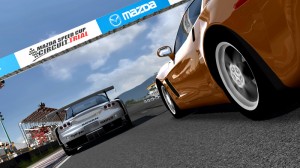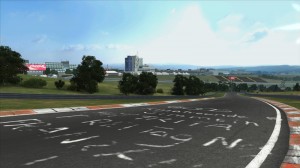You wouldn’t know it by reading this blog, but one of the few video gaming genres I have loved unconditionally my entire life, ever since I was old enough and tall enough to reach the sticks on arcade cabinets, has been car driving and racing. I have fond memories of Pole Position; consider the OutRun soundtrack to be the greatest in the medium’s history; have smiled with Cruisin’ USA, gritted my teeth courtesy of Crazy Taxi, and laughed over manic multiplayer Mario Kart DS sessions. And even though I eventually gave up on Grand Theft Auto: Vice City, and open-world games in general, I took immense pleasure in simply cruising around a loving parody of the very real Miami Beach that I had spent much time in when I was younger, listening to the ’80s tunes and satirical talk shows on the radio. All of this is especially ironic since I have no interest in driving in real life and, in fact, only ever did so for a very short time.
 But yes, I love driving games, even though I’m not very good at a lot of them. This last bit is why I don’t buy them all that often, and why, until recently, the first and last simulation racer I had ever bought was Gran Turismo 3 A-Spec, which came bundled with my first PlayStation 2. I had heard fantastic things about the Gran Turismo series, and this latest (at the time) entry in the series looked damned pretty, so for this casual driving game lover, I thought it was a no-brainer. However, my problem was just that: I was a casual driving game lover, and GT3 was very, very serious. In career mode, I got a starting car and some circuits to race on, but to save up enough money to upgrade from my lowly PT Cruiser was going to be a tedious task, and I never stuck with it. Of course, it didn’t help that the license tests, required to unlock the higher-level races, demand a certain sort of precision which my casual self couldn’t possibly hope (or want) to deliver.
But yes, I love driving games, even though I’m not very good at a lot of them. This last bit is why I don’t buy them all that often, and why, until recently, the first and last simulation racer I had ever bought was Gran Turismo 3 A-Spec, which came bundled with my first PlayStation 2. I had heard fantastic things about the Gran Turismo series, and this latest (at the time) entry in the series looked damned pretty, so for this casual driving game lover, I thought it was a no-brainer. However, my problem was just that: I was a casual driving game lover, and GT3 was very, very serious. In career mode, I got a starting car and some circuits to race on, but to save up enough money to upgrade from my lowly PT Cruiser was going to be a tedious task, and I never stuck with it. Of course, it didn’t help that the license tests, required to unlock the higher-level races, demand a certain sort of precision which my casual self couldn’t possibly hope (or want) to deliver.
I eventually set Gran Turismo 3 aside for other games, including the simpler but much more accessible go-kart racer Mario Kart DS, and ended up never touching it again. Another console generation rolled around. I picked up Mario Kart Wii and went through the entire Grand Prix in that, as I had with its predecessor, but it wasn’t enough. I wanted a more robust racing experience, something like Gran Turismo, but given my past experience, I had to do my research more carefully this time. We don’t have a PS3, but we do have an Xbox 360, and the Xbox brand’s equivalent of GT was Turn 10’s Forza Motorsport, so I began looking into that series. I already knew of its reputation for delivering as deep and realistic an experience as Polyphony Digital’s “Real Driving Simulator”, but could I play a Forza game and still have fun?
The answer? A resounding yes.
As I was doing this research, Forza Motorsport 3 was hitting store shelves, but I focused most of my attention on its predecessor, Forza 2. Not only was it cheaper than the newer game, but it is also now a repackaged Platinum Hit, with a bonus disk that contains all of the official DLC that ever came out for the game, including previously exclusive content. It was this review at Eurogamer, which discussed the game’s content from both the Serious Racing Gamer and Casual Racing Gamer perspectives, that sold me. After wishlisting Forza Motorsport 2, only to not get it for Christmas, I picked it up on my own and yesterday, logged into my Xbox Live account and sat down to play it for the first time. (Brief non-sequitur: oddly echoing my experience with GT3 on the PS2, this is the first non-demo Xbox 360 game I’ve ever played.)
 First, I dove into the Career mode, in which you are given a wide variety of options to start off with, beginning with three different regions (North America, Japan, or Europe), the decision of which affects certain other factors later on. I went with North America, and was then presented with a decent range of starting models, not an ugly one in the bunch. Believe me, it is so much nicer having an Acura RSX Type-S as a starter than a PT Cruiser. There are several difficulty modifiers to make races as easy or as hard as you want them to, but at a price; the easier you make a race, the more credits get subtracted from your earnings when you win. Not only does this make you not feel as dumb when you “dumb down” the difficulty, but it keeps the game difficult in other ways; less credits means slower leveling (yes, the “RPG elements” that are all the rage make something of an appearance here), as well as less cash to spend on cars and upgrades. And speaking of upgrades, there’s a whole mess of them, enough to normally confuse and confound casual types like me, but fortunately, there’s also handy in-game explanations of what all of those bits and bobs do and how they’ll help you get better performance on the racetrack.
First, I dove into the Career mode, in which you are given a wide variety of options to start off with, beginning with three different regions (North America, Japan, or Europe), the decision of which affects certain other factors later on. I went with North America, and was then presented with a decent range of starting models, not an ugly one in the bunch. Believe me, it is so much nicer having an Acura RSX Type-S as a starter than a PT Cruiser. There are several difficulty modifiers to make races as easy or as hard as you want them to, but at a price; the easier you make a race, the more credits get subtracted from your earnings when you win. Not only does this make you not feel as dumb when you “dumb down” the difficulty, but it keeps the game difficult in other ways; less credits means slower leveling (yes, the “RPG elements” that are all the rage make something of an appearance here), as well as less cash to spend on cars and upgrades. And speaking of upgrades, there’s a whole mess of them, enough to normally confuse and confound casual types like me, but fortunately, there’s also handy in-game explanations of what all of those bits and bobs do and how they’ll help you get better performance on the racetrack.
Spending credits isn’t the only way to add to your garage. Specific cars can be won as prizes by placing first in events, and, using Xbox Live, cars can be traded between players through auction house and gifting systems. Leveling up and doing specific actions in-game will drip out other benefits as well, including car and upgrade discounts; at one point, I was even given a car by meeting a certain set of criteria. This steady stream of unlocks is a nice carrot/stick approach that brings to mind another series that tends to do this same thing very well and has a sizable following, both hardcore and casual: Dance Dance Revolution. This is most definitely not a bad thing. Here’s something else that brings to mind DDR: the Test Drive feature, which is not unlike the dance series’ practice mode. Going out for test drives is a great way to get the feel of a new car, or a newly-customized one, without being bothered by the pressure of racing.
 Oh, and then there’s the customization! Forza Motorsport 2 lets you paint your cars in an astounding array of regular and metallic hues, plus allows for a startling amount of creativity with its decal application tools. My only quibble here has to do with the controls, which are insufficient if one wants to create something elaborate, and sadly, there doesn’t seem to be a way to use a Wacom tablet with the game. The in-game photography features are just as robust, but again (albeit to a lesser degree), true refinement is limited by the nature of the hardware. Photos taken can be uploaded onto the official website, and I would share some of the shots I took in preparation for this post, but the site’s slow and they haven’t shown up. (I later tried a more routine video capture method, but as luck would have it, my equipment hates me today.) Sorry that you aren’t going to get to see the cute yellow Audi I bought and painted with a bee theme last night; instead, this post is illustrated with the regular old official screens. (ETA, 1/26/10: Just learned that the viewing-photos-from-the-website feature, among others, is only be available to Xbox Live Gold subscribers, a detail which is mentioned nowhere in the manual. While it’s true that [1] I’m new to the 360 and [2] Microsoft assumes Gold as a given, I wasn’t aware of how crucial it is to the experience. In Forza 2‘s case, just a quick note in the manual could’ve made things all the less frustrating.)
Oh, and then there’s the customization! Forza Motorsport 2 lets you paint your cars in an astounding array of regular and metallic hues, plus allows for a startling amount of creativity with its decal application tools. My only quibble here has to do with the controls, which are insufficient if one wants to create something elaborate, and sadly, there doesn’t seem to be a way to use a Wacom tablet with the game. The in-game photography features are just as robust, but again (albeit to a lesser degree), true refinement is limited by the nature of the hardware. Photos taken can be uploaded onto the official website, and I would share some of the shots I took in preparation for this post, but the site’s slow and they haven’t shown up. (I later tried a more routine video capture method, but as luck would have it, my equipment hates me today.) Sorry that you aren’t going to get to see the cute yellow Audi I bought and painted with a bee theme last night; instead, this post is illustrated with the regular old official screens. (ETA, 1/26/10: Just learned that the viewing-photos-from-the-website feature, among others, is only be available to Xbox Live Gold subscribers, a detail which is mentioned nowhere in the manual. While it’s true that [1] I’m new to the 360 and [2] Microsoft assumes Gold as a given, I wasn’t aware of how crucial it is to the experience. In Forza 2‘s case, just a quick note in the manual could’ve made things all the less frustrating.)
Building up a career isn’t the only thing Forza 2 has going for it; a pick-up-and-play Arcade mode is available as well, where cars from any and every class can be raced on different speedways. The set-up here is a bit more traditional, but it still contains the lure of unlocks and a large variety of starting vehicles; in one of my earliest exhibition races, I was able to pick from a handful of gorgeous Ferarris, among several others.
So, by now, you all are probably asking the obvious: how is the actual racing? Well, it’s about what you’d expect, and want, from a top-tier simulation racer. Physics are realistic, and the type of car you drive, and how you customize and tune it, make a noticeable difference. There’s real weight to each vehicle, both yours and your opponents’, and the surfaces are just as responsive as the cars. As detail-oriented as the rest of the game is, it would be a shame if it fell apart where it mattered most, so it’s a pleasure to see that it doesn’t.
Anyway, that’s my experience with Forza 2 so far; note that I haven’t played any online matches, nor do I intend to unless I somehow come across a really great group to play with. Simply put, Forza 2 is the sim racer I wanted from GT3 but didn’t get: not only are there great graphics, realistic sim racing, a slick interface, and pulse-pounding music, but there’s so much more. The starting options were broad and enticing enough to draw me in, and a steady stream of unlocks and rewards—not to mention the promise of more great driving—have given me the incentive to keep going. Not having to go though any damned license tests is a nice plus, too, of course. It’s an enthralling drive, so to speak, and I can see myself playing Forza 2 a lot throughout this year, if not longer.